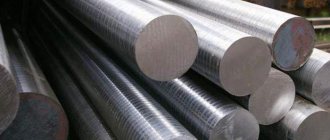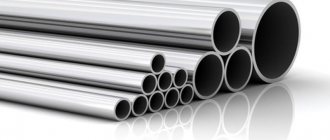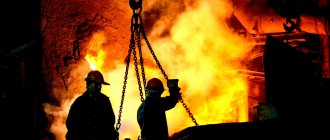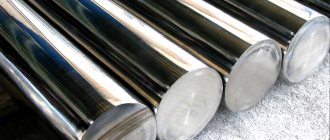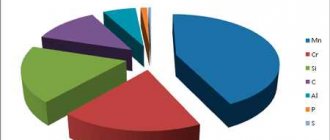Electrical steel is a type of ferrous rolled metal, unalloyed or alloyed with silicon and aluminum with specified ferromagnetic properties. It is widely used in high- and low-current production of electrical equipment and electrical goods for general consumption. Magnetic cores are made from it, designed to operate in magnetic fields when the magnetization vector changes with a frequency of up to 400 Hz. At the same time, steel has a low affordable price and a high level of induction.
Effect of silicon content on steel properties
Electrical steel is a soft ferromagnetic material with improved properties. Its distinctive feature is to establish an abrupt change in the properties of the material below the Curie point temperature, which results in spontaneous magnetization. Steel acquires ferromagnetic properties due to the ordered parallel arrangement of the magnetic moments of electrons. That is, the material acquires the properties of a magnet without the presence of a magnetic field.
To increase the magnetic properties of iron, it is doped with silicon. With the introduction of iron silicide FeSi, the electrical resistance increases, the saturation induction increases, and the alloy reaches the maximum possible level of magnetization. The most harmful form of carbon for the magnetic properties of the alloy transforms from cementite into graphite. Silicon helps to minimize magnetic anisotropy and establish stable magnetic field values in all directions of the steel. Reducing magnetostriction (changes in the volume and size of ferromagnetic parts) reduces the level of noise and vibration, which reduces discomfort and preserves devices and parts from destruction.
Example of electrical steel
The amount of alloying element shapes the properties of the ferroalloy and affects the quality characteristics. But with the addition of silicon over 4.38%, the steel acquires a coarse-grained structure, which increases its hardness and brittleness, and reduces ductility and strength. Silicon guarantees the stability of magnetic properties and reduces its aging time.
Alloying with aluminum is used in the production of mild steels to remove oxygen from the alloy, which forms voids in the material, reduces strength, and increases brittleness.
The silicon content is strictly regulated by standards and regulations and varies depending on the purpose and type of material from 0.8% to 4.8%.
Silicon steel
This type of metal is the main soft magnetic material that has mass consumption. Silicon is contained in steel in varying quantities. This depends on what level of magnetic properties is required. Thanks to silicon, the resistivity of steel increases, and the coercive force decreases, and hysteresis losses are also reduced.
If silicon contains 5% or more, the mechanical properties deteriorate significantly: fragility and hardness increase. This type of steel is not suitable for stamping.
Properties of electrical steel
Changes associated with the addition of silicon improve the properties of electrical steel:
- The higher the electrical resistivity, the greater the ability of the material to prevent the passage of electric current. This reduces its losses and prevents the formation of eddy currents, which cause heating of the core and electrical protective devices.
- The soft magnetic ferroalloy from which transformers, generators, controllers, relays, and transmitters are made must have a low coercive force. For steel, which is used for the production of magnetic circuits, cores and magnets, the highest possible. The coercive force value shows the strength of the external magnetic field, which leads to complete demagnetization of the steel. It is increased by increasing the silicon content.
- The hysteresis loop is characterized by its width. The wider it is, the more time it will take for the electrical components to restore their original parameters. As the width decreases, the time period for restoring the original values and relieving mechanical stress decreases.
- Magnetic permeability characterizes the ability of the magnetic moments of electrons to orient in parallel when exposed to an external magnetic field. An increase in the magnetic permeability coefficient leads to a decrease in eddy current losses and a decrease in the hysteresis loop. The coefficient depends on the magnitude of the external magnetic field.
- The thickness of produced transformer steel sheets varies from 0.05 to 2 mm.
The listed properties ensure reliable operation of electrical parts made of ferroalloy and increase their service life.
Lamination coatings
Electrical steel is typically coated to increase electrical resistance between layers, reduce eddy currents to provide resistance to corrosion or rust, and act as a lubricant during die cutting. There are different coatings, organic and inorganic, and the coating used depends on the application of the steel.[11] The type of coating chosen depends on the heat treatment of the laminate, whether the finished laminate will be immersed in oil, and the operating temperature of the finished unit. Very early practice was to insulate each wafer with a layer of paper or a varnish coating, but this reduced the core summation factor and limited the maximum core temperature.[12]
ASTM A976-03 classifies various types of coatings for electrical steel.[13]
| Classification | Description[14] | For rotors/stators | Non-stick coating |
| C0 | Natural oxide formed during mill processing | No | No |
| C2 | Glass like film | No | No |
| C3 | Organic enamel or varnish coating | No | No |
| C3A | Like C3, but thinner | Yes | No |
| C4 | Coating obtained as a result of chemical and thermal treatment | No | No |
| C4A | Same as C4, but thinner and weldable | Yes | No |
| C4AS | Option C4 with non-stick coating | Yes | Yes |
| C5 | High durability, similar to inorganic filler C4 plus | No | No |
| C5A | Like C5, but more weldable | Yes | No |
| C5AS | Option C5 with non-stick coating | Yes | Yes |
| C6 | Organic coating with inorganic filler for insulating properties | Yes | Yes |
ETS production
Electrical steel is smelted in blast furnaces at a temperature of 1500-16500 C using the complete oxidation method, which reduces the content of oxygen and harmful impurities in the material to a minimum. Mild steel is obtained, which is cast into ingots or platinum weighing from 0.5 tons or slabs measuring 140X630 mm and 140X1000 mm.
The most popular grades of non-alloy steel: 10880, 10895, 10850, 10860, 11880, 11895, 20880, 21880, 21895 and others, where the first digit indicates the class according to the type of pressure treatment:
- Digit 1 (hot rolled and forged),
- Number 2 (calibrated) shows that the steel has undergone additional processing by cold drawing with a change in the size of the workpiece using roll compression.
The second number shows the silicon content in the workpiece:
- 0 – unalloyed with a silicon content of up to 0.03% without an established aging coefficient (changes in the properties of the metal over time),
- 1 – the aging coefficient is set, that is, the absence of changes in the properties and microstructure of the material is guaranteed.
The number 8 indicates the main qualitative indicator, for this type it is the coercive force.
The fourth and fifth digits establish a quantitative indicator of the coercive force for a given class of steel in whole units of ampere/meter.
Types, ferromagnetic properties and physical quality indicators are formed during the process of rolling blanks into thin sheets or strips.
At the stage of obtaining rolled sheets from steel blanks, two production technologies are used: hot-rolled and cold-rolled processing.
The hot-rolling method involves preheating the slabs to a temperature of 800-13000 C. Then the heated billets are fed to the rolling mill. A rolling mill is a set of alternating rolls with different gap thicknesses between them. The heated workpiece, passing alternately between them, under pressure with the help of plastic deformation, changes the thickness from 7.5 mm-60 mm to 0.05 mm-2 mm. Preheating increases the ductility of the material, but the increased temperature changes the properties of the steel.
Hot rolled electrical steels contain the maximum possible amount of silicon from 3.5% to 4.5%. It has a coarse-crystalline structure with a random arrangement of grains, which reduces its magnetic characteristics. After rolling, the physical properties are the same in all directions, so hot-rolled steel is only isotropic.
Cold-rolled electric steel is produced at ambient temperature in two stages. At the first stage, sheet metal is rolled to a thickness of more than 0.5 mm. Then the steel is cut into sheets or rolled into a roll and annealed at a temperature of 1150-11800 C, followed by rolling to the required thickness. Cold rolled steel can be isotropic or anisotropic. Anisotropic materials have physical properties that are enhanced along the movement of the rolls, which leads to strict structuring of electromagnetic fluxes along the horizontal axis of the metal grains.
Application
From sheet materials of the first class, you can make different types of magnetic circuits for relays and regulators.
Electrical steel of the second class grade can be used for starters of direct and alternating current electric machines, rotor cores.
The third class will be suitable for the manufacture of magnetic cores for power transformers, as well as starters for large synchronous machines.
To make a frame for an electric machine, you need to use steel casting, in which the carbon content is no more than 1%. Products made from such material are subjected to gradual annealing. Carbon steel is used in the manufacture of machine parts that undergo welding.
These types of materials are used to make main poles for DC machines.
For those machine parts that bear the maximum load (springs, rotors, armature shafts), alloys with high mechanical properties are used. Such material may contain nickel, chromium, molybdenum and tungsten. It is possible to produce magnetic cores from electrical steel. They are used for low frequency transformers - 50Hz.
Types and chemical composition of steel
To improve adhesion and anti-corrosion properties, ETS products are coated with a layer of insulation, which does not affect the magnetic properties and ability to transmit electric current. These include coatings based on enamels, varnishes, glass enamel and polymers.
Depending on the silicon content, steel is divided into:
- Transformer with silicon content from 3.0% to 4.5%,
- Dynamic with a degree of silicon doping from 0.8% to 2.5%.
Steel is considered unalloyed if the silicon content does not exceed 0.3%. In addition to it, the composition of unalloyed electrical steel includes: Mn up to 0.3%, S at least 0.03%, P up to 0.02% and Cu up to 0.3%.
Soft magnetic alloy steel, in addition to silicon 0.2%, contains up to 0.3% manganese, from 15.5 to 16.5% chromium, 0.3% nickel, from 0.01% to 0.015% sulfur, phosphorus, respectively, no whiter 0.015%, 0.1% molybdenum and 0.2% titanium.
Electrical transformer steel is alloyed with iron silicide FeSi. With its help, iron oxides are reduced, carbon turns into graphite, and the alloy is freed from oxygen, which has a negative effect on the structure of the metal and its magnetic properties.
Transformer iron is produced by hot and cold rolling. The number of grades reaches 79, with specified properties of resistivity, resistance to the formation of vortex magnetic fields, a narrow hysteresis loop, and high induction. Alloyed isotropic materials are used for the manufacture of high-precision power equipment: transformers, rectifiers, generators, electric motors.
A transformer is a device with several windings that, using electromagnetic induction, changes the magnitude of alternating current and voltage. The conversion takes place without changing the frequency and power of the electric current.
The transformer core is assembled from thin plates. The metal letter E or the metal letter Ш, depending on which angle one views the component of the core, is made of sulfur steel. Steel 3414 with a silicon content of 2.8-3.8%, cold-rolled anisotropic, density 7650 kg/m3, thickness 0.35-0.5 mm, with specific losses 1.1-1.5 W/kg.
Dynamic steel is used for the manufacture of low-current products, which include cheap electrical products for all types of industrial equipment and household electrical appliances. The most widely used grade is steel 2212. This is sulfur, isotropic cold-rolled steel with a thickness of 0.5-0.65 mm, a density of 7800 kg/m3, and a silicon content of 0.8-1.8%.
The purposes of using electrical steels are related to the increase in the use of electricity. It must be transported to the consumer with minimal losses, without changing the specified parameters of the electrical networks from various sources of its production.
Recommendations
- ^ a b c
Tong, Colin (2018).
Introduction to Materials for Advanced Energy Systems
. Springer. P. 400–. ISBN 978-3-319-98002-7. - Bushoul, K.H.J. and others. ed. (2001) Encyclopedia of Materials: Science and Technology
. Elsevier. pp. 4807–4808. ISBN 0-08-043152-6 - Sidor, Yu.; Kovacs, F. (2005). "Contribution to Modeling the Decarburization Process of Electrical Steels" (PDF). Bulletin of Lviv University.
The series is physical .
38
: 8–17. - "ASTM A867". ASTM. Retrieved December 1, 2011.
- "Silicon core" A"". CarTech. Retrieved December 1, 2011.
- "Silicon core" A-FM "". CarTech. Retrieved December 1, 2011.
- ^ a b
"CarTech® Silicon Core Iron" B-FM". CarTech. - Iron with silicon core CarTech® C"". CarTech. Retrieved November 21, 2022.
- Niazi, A.; Pieri, J. B.; Berger, E.; Juthi, R. (1975). "A note on the electromigration of grain boundaries in silicon iron". Journal of Materials Science
.
10
(2): 361–362. Bibcode:1975JMatS..10..361N. Doi:10.1007/BF00540359. - There you go, Eddie. "Single-ended and push-pull: the deep dark secrets of output transformers" (PDF).
- Fink, Donald G. and Beatty, H. Wayne (1978) Standard Manual for Electrical Engineers
11th ed. McGraw-Hill. pp. 4–111. ISBN 978-0070209749 - ^ a b
Jump, Forest (March 1981)
Transformer Steel and Cores
, Federal Pioneer BAT - "ASTM A976-03 (2008) Standard Classification of Insulating Coatings by Composition, Relative Insulating Capacity, and Application." ASTM A976-03(2008)
. ASTM. - "Classification of insulating coatings for electrical steel" (PDF). Retrieved March 27, 2013.
- IEC 60404-2
- de Lorbe, Richard (June/July 1981) Steel No Lasers Here
, Federal Pioneer BAT - Overview of the electrical steel market. Product inside
. 15-02-2020.
ACCEPTANCE RULES
3.1. Rolled steel, sheets and tapes are accepted in batches. The batch must consist of steel from one heat, one grade, one thickness, one annealing when annealing in bell-type furnaces or one roll when annealing in continuous furnaces and be accompanied by a quality document in accordance with GOST 7566 with the addition:
recommended heat treatment regime for steel produced without heat treatment;
values of magnetic properties measured on a longitudinal sample for a tape less than 300 mm wide.
(Changed edition, Amendment No. 1, 5).
3.2. Control of dimensions, thickness variation, non-flatness, crescent shape, surface and edge condition, bending tests, magnetic properties, resistance coefficient, surface adhesion strength is carried out on one roll or one pack from the batch.
Tape and sheets obtained by cutting one roll into specified widths or lengths are tested as one roll.
3.3. The manufacturer periodically determines the aging coefficient, fill factor, anisotropy coefficient of specific magnetic losses or magnetic induction and residual stresses on at least 35 batches per quarter. Mechanical properties are determined on every tenth heat. The obtained values are averaged.
At the request of the consumer, the coefficient of anisotropy of specific magnetic losses or anisotropy of magnetic induction is determined for each batch.
The heat resistance of the coating is ensured by its chemical base and application technology.
If unsatisfactory results from periodic tests are obtained, they are transferred to acceptance tests until a positive result is obtained on three batches in a row. The results of periodic tests are indicated in the quality document at the request of the consumer.
3.2, 3.3. (Changed edition, Amendment No. 5).
3.4. If unsatisfactory test results are obtained for at least one of the indicators, a repeat test for it is carried out on a sample selected in accordance with GOST 7566.
